
Dressing for an interview? I'm genuinely curious on what people currently dress in for interviews. So curious what people are wearing to interviews now days.
Knowing what to wear for a job interview is a crucial step in your overall interview preparation. Your clothing choices not only affect first impressions but also communicate your professionalism and awareness of the company culture. Dressing appropriately can subtly signal your fit for the organization and the role you’re applying for.
When deciding on your job interview attire, it’s important to research the company’s dress code and industry standards. Different workplaces have different expectations—what’s suitable for a corporate finance firm may differ from a creative startup. Tailoring your outfit to align with the company’s culture shows that you’ve done your homework and respect their environment. If you’re also preparing your application documents, consider using a well-structured format, like the one in our Google Docs resume guide, to complement your professional image.
In recent years, many companies have adopted more relaxed dress codes, especially with the increase of remote work and hybrid models, according to the Society for Human Resource Management (SHRM). However, even if a workplace embraces casual dress, it’s still advisable to opt for polished, professional clothing that reflects your seriousness and commitment to the opportunity. Knowing how to present yourself visually during an interview can make the final steps—like knowing how to accept a job offer—feel more confident and natural. If you’re new to interviewing or want to polish your communication skills, our guide on how to respond to an interview request can help you prepare every step before the big day.
Choosing the right interview outfit can boost your confidence and help you make a positive impression. In the following sections, you’ll find practical advice on how to select the best clothes for your next job interview, from business formal to business casual, so you can walk in feeling prepared and confident.
I’ll never forget my first interview—I was so nervous picking out my clothes! But once I got it right, I felt like I could handle anything. That’s why figuring out how to dress for a job interview is so important!
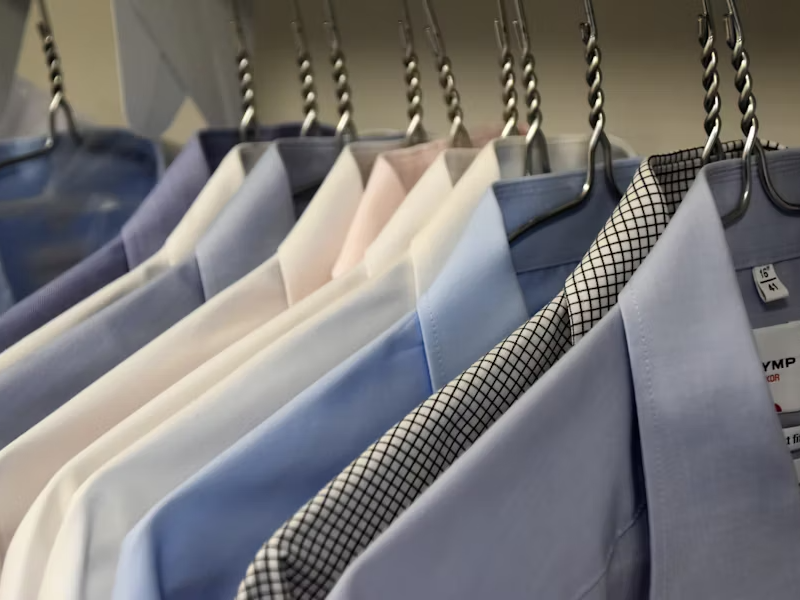
Is Interview Attire Important
Absolutely! Choosing the right outfit plays a vital role in creating a polished and professional image. Especially in business and business casual settings, your interview attire can set the tone for how employers perceive your level of seriousness and respect for the opportunity. Wearing a well-fitted blouse, tailored pants, or a crisp dress shirt signals that you’ve made an effort to present yourself confidently, helping you leave a strong and positive first impression.
On the other hand, selecting inappropriate or careless clothing can work against you. The wrong outfit may cause hiring managers to question your understanding of the company culture or your professionalism, potentially impacting their perception of your fit for the role. That’s why knowing exactly what to wear for a job interview is just as important as preparing your answers.
Should You Wear a Suit
Right outfit for a job interview is crucial to making a strong first impression. The ideal attire depends on the industry, company culture, and role you're applying for. Understanding what to wear for a job interview can set you apart and boost your confidence. According to SHRM, context is key in deciding whether a formal black suit, a polished jacket and tie, or a professional combination like a dress shirt with tailored pants is most appropriate.
For industries like banking, law, or corporate settings, formal business attire is often expected. Men might opt for a well-fitted suit, dress shirt, and tie, while women may choose a professional dress, skirt suit, or tailored pantsuit. Neutral colors like navy, black, or gray convey professionalism, while accessories like polished dress shoes and subtle jewelry enhance your look without being distracting.
In less formal industries, such as tech or creative fields, business casual attire may suffice. A crisp blouse or button-down shirt paired with dress pants or a skirt, complemented by clean, professional shoes, can strike the right balance. For example, men could wear a blazer with chinos, while women might choose a smart blouse with tailored trousers or a modest dress. Always ensure your outfit is clean, ironed, and fits well to project confidence and competence.
How to Decide What to Wear to a Job Interview
Selecting the perfect outfit for a job interview is a critical step in making a lasting first impression. To nail how to dress for a job interview, a bit of research and strategic planning can go a long way. By aligning your attire with the company culture, industry expectations, and role requirements, you’ll exude confidence and professionalism. Here’s how to choose the ideal job interview attire while feeling comfortable and authentic.
Research the Company Culture
Start by investigating the company’s vibe to guide your outfit choice. Visit their website, LinkedIn, or social media pages like Instagram or X to gauge their dress code. Are employees in sharp suits, or do they lean toward a relaxed, business casual look? For instance, a corporate bank or law firm often expects formal business attire, such as a tailored suit in neutral tones like navy, black, or gray. In contrast, a tech startup or creative agency might welcome a smart yet laid-back ensemble, like a blazer with chinos or a polished blouse with tailored trousers. Understanding the workplace environment helps you blend in while standing out as a prepared candidate.
Consider the Industry and Role
The industry and position you’re applying for play a significant role in determining your interview outfit. For high-stakes fields like finance, legal, or executive roles, opt for professional attire such as a well-fitted suit, dress shirt, and tie for men, or a pantsuit, skirt suit, or professional dress for women. Subtle accessories, like a classic watch or minimal jewelry, and polished dress shoes complete the look. In creative industries like graphic design, marketing, or media, you can showcase some personality with business casual interview attire—think a stylish blazer, dress pants, or a chic midi skirt paired with a crisp top. Ensure your outfit is clean, ironed, and fits impeccably to convey competence.
Factor in Comfort and Weather
Comfort is key. Avoid outfits that feel restrictive or cause discomfort, like tight shoes or overly heavy layers, as they can distract you during the conversation. Check the weather forecast and adapt accordingly. For summer interviews, lightweight fabrics like breathable cotton or linen blends work well, especially in casual settings. In colder months, layer smartly with a wool blazer or a tailored coat that complements your professional look. Choosing attire that balances comfort and style ensures you feel confident and focused.
Tips for Polishing Your Interview Look
- Lean Slightly Formal: When in doubt, it’s better to dress slightly more formal than too casual. A polished appearance signals you take the opportunity seriously.
- Pay Attention to Details: Ensure shoes are clean, clothes are wrinkle-free, and accessories are minimal to avoid distractions.
- Test Your Outfit: Try on your interview attire beforehand to confirm it fits well and feels good, allowing you to move naturally.
- Prepare Beyond Your Outfit: While your appearance matters, don’t forget to refine your resume and practice common interview questions. Tools like Google Docs can help you craft a professional resume if you’re starting from scratch.
By researching the company, aligning your outfit with industry norms, and prioritizing comfort, you’ll confidently decide clothes for a job interview. A well-chosen outfit not only enhances your appearance but also boosts your self-assurance, helping you shine during the interview.
Job Interview Outfits by Workplace Type
Dressing appropriately for a job interview starts with understanding the workplace you’re stepping into. Every company has its own vibe, and your outfit should reflect that while showing you’re serious about the role. To help you nail this, let’s break it down by workplace type. Whether it’s a laid-back startup or a buttoned-up law firm, the right clothes can set you up for success. Here’s how to dress for three common environments: casual, business casual, and formal. Just as choosing the right outfit shows professionalism, using the best font size on your resume reflects attention to detail.
What to Wear to a Casual Interview
Even for a casual interview, looking polished and put-together is key to standing out. Opt for neat, well-fitted jeans or chinos paired with a clean, professional top, such as a blouse, collared shirt, or lightweight sweater. Complete the look with closed-toe flats, loafers, or polished sneakers in a neutral color to maintain a professional edge. For example, startups, creative agencies, or tech companies often have relaxed dress codes, but as a candidate, it’s wise to elevate your attire slightly above the everyday employee standard to show respect for the role.
Focus on fit and cleanliness to avoid looking too laid-back. Avoid distressed clothing, like ripped jeans, or overly casual items, such as graphic tees. A personal anecdote: I once considered wearing my favorite ripped jeans to a casual office interview but opted for tailored chinos and a crisp blouse instead—thankfully, as it showed I took the opportunity seriously. If the company explicitly states “casual is fine” or you notice employees wearing jeans on their website or social media, you can ease up slightly, but always prioritize a tidy, professional appearance.
Key Tips for Casual Interview Attire:
- Choose well-fitted, clean clothing to convey professionalism.
- Opt for neutral or muted colors to keep the look polished.
- Avoid overly casual items like sneakers with bold logos or worn-out clothing.
What to Wear to a Business Casual Interview
Business casual interview attire strikes a perfect balance between formal and relaxed, making it ideal for industries like marketing, education, or mid-level corporate roles. For men, consider chinos or dress pants paired with a button-down shirt and a blazer or cardigan for a refined touch. Women can opt for a blouse with a pencil skirt, tailored trousers, or a modest dress, complemented by a blazer or lightweight cardigan. Footwear like loafers, low heels, or dressy flats in neutral tones completes the ensemble. You can add a hint of personality with a soft color (like pastel blue or blush) or a subtle accessory, such as a classic watch or small earrings.
The key to nailing business casual is ensuring everything is ironed, fits well, and looks professional. For instance, a white button-down shirt with khakis and a navy blazer creates an approachable yet serious look. Avoid baggy clothing or overly bold patterns, as they can detract from your polished appearance. Researching the company’s dress code via their website or social media can help you gauge the expected level of formality.
Key Tips for Business Casual Interview Attire:
- Ensure clothing is well-fitted, clean, and wrinkle-free.
- Add a structured piece, like a blazer, to elevate the outfit.
- Use subtle accessories to show personality without overwhelming the look.
What to Wear to a Formal Interview
For formal interviews, common in industries like finance, law, or high-level corporate positions, a professional and structured outfit is non-negotiable. A well-tailored suit in a neutral color like navy, gray, or black is the go-to choice. Men should pair the suit with a crisp dress shirt and a conservative tie, while women can choose a pantsuit, skirt suit, or a professional dress with a blazer. Polished dress shoes or modest heels in black or brown complete the look, ensuring a sharp and sophisticated appearance.
The formal interview outfit should exude confidence and respect for the role. I recall suiting up for a bank interview—it felt like putting on armor, boosting my confidence instantly. Stick to conservative choices, avoiding flashy patterns or overly bright colors. Simplicity and fit are paramount; ensure your suit is tailored to your frame and your shoes are clean and scuff-free. Subtle accessories, like a tie clip or minimal jewelry, can add polish without being distracting.
Key Tips for Formal Interview Attire:
- Choose a tailored suit in a neutral color for a timeless, professional look.
- Keep accessories minimal and conservative to maintain focus on your qualifications.
- Double-check that your outfit is pressed and fits perfectly to project confidence.
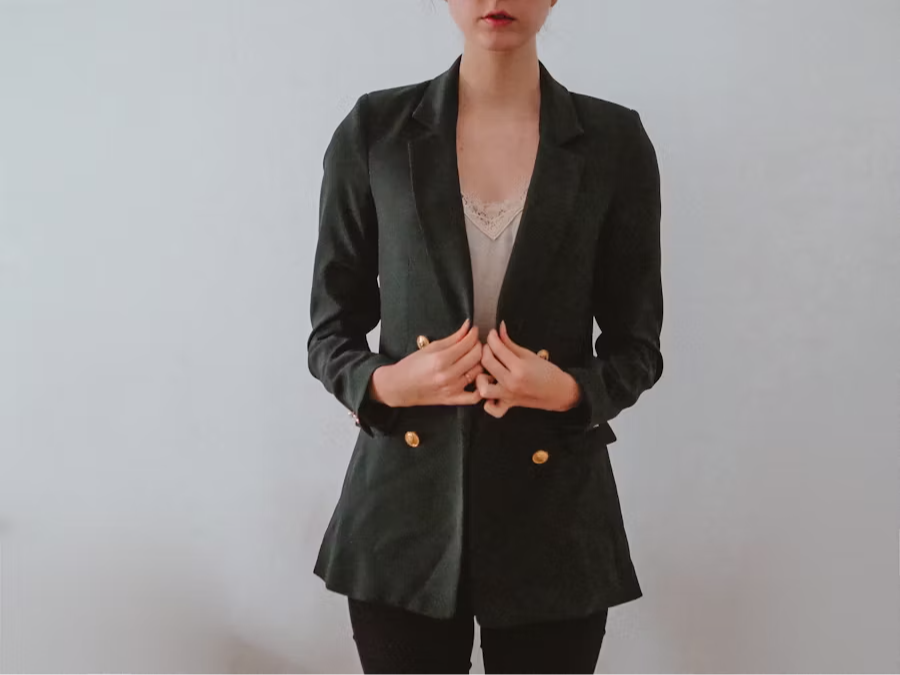
Recommended Clothing Items by Category
Once you’ve got a sense of the workplace dress code, and chose pieces that align with the company’s culture and industry, you can create a polished, professional look that exudes confidence. This guide breaks down essential clothing categories—tops, bottoms, dresses, shoes, and accessories—with practical tips to help you build a cohesive and appropriate job interview attire. Whether aiming for casual, business casual, or formal, these recommendations ensure you’re prepared to shine.
Tops for a Professional Interview Look
Your top sets the tone for your entire outfit and should scream professionalism. Opt for polished options like blouses, collared shirts, or neatly fitted sweaters in neutral or soft tones such as white, light blue, or cream. Layering with a tailored blazer or cardigan elevates your look, adding a professional edge suitable for most interview settings. For example, a crisp white blouse paired with a navy blazer is a timeless, versatile choice for business casual or formal interviews.
Avoid low necklines, sheer fabrics, or overly bright patterns to maintain a workplace-appropriate vibe. Ensure your top is ironed, fits well, and feels comfortable to boost your confidence.

PRO TIP
Select a top that aligns with the industry—crisp and structured for corporate roles, slightly relaxed for creative fields.
Bottoms to Complete Your Interview Outfit
Bottoms are the foundation of a polished interview look and should appear tailored and clean. Choose slacks, ankle-length dress pants, or knee-length skirts in high-quality fabrics like cotton, wool, or a blend, sticking to neutral colors such as black, gray, navy, or charcoal. For instance, well-fitted black slacks paired with a blouse create a sleek, professional ensemble that works across industries like finance, marketing, or education.
Steer clear of overly tight, distressed, or baggy bottoms, as they can undermine your professional appearance.

PRO TIP
When deciding what to wear for a job interview, ensure your bottoms complement your top and fit your body shape perfectly, creating a balanced and put-together look.
Dresses for a One-and-Done Interview Look
A dress can be a simple yet effective choice for a job interview, offering a polished look in one piece. Opt for knee-length or midi dresses in solid colors like navy, black, or gray, or subtle patterns like pinstripes for a professional touch. Pairing a navy midi dress with a blazer or cardigan adds formality, making it suitable for business casual or formal settings, such as corporate or legal interviews.
Ensure the dress isn’t too short, tight, or revealing to maintain a work-ready appearance.

PRO TIP
A dress is ideal for the interview if it feels comfortable and aligns with the company’s dress code—check their website or social media for clues about their style.
Shoes to Step Up Your Interview Game
Shoes may seem like a small detail, but they play a significant role in completing your job interview attire. Choose closed-toe dress shoes, flats, or low heels in neutral colors like black, brown, or nude to match your outfit’s tone. For casual interviews at startups or creative firms, polished loafers or clean, minimalist sneakers can work, while formal settings like finance or law call for sleek dress shoes. Comfort is critical—avoid shoes that pinch or cause discomfort, as you’ll want to walk confidently.
Keep shoes clean and scuff-free to maintain a professional look.

PRO TIP
Test your shoes beforehand to ensure they’re comfortable for standing or walking during the interview process.
Accessories to Enhance Your Professional Appearance
Accessories should complement, not overshadow, your interview outfit. Opt for subtle, classy pieces like a small necklace, a classic watch, or a simple belt to add a refined touch. For example, a delicate chain necklace or a leather-strap watch can elevate your look without being distracting. Avoid large, flashy jewelry or bold accessories that might draw attention away from your qualifications.

PRO TIP
When choosing accessories for an interview, less is more—one or two understated pieces keep your look professional and polished, suitable for any industry, from tech to corporate.
What Not to Wear to a Job Interview
Learning how to dress for a job interview also means understanding what to avoid. Certain clothing choices can hurt your chances, no matter how strong your qualifications are. For example, jeans are usually too casual unless you’re absolutely certain the company culture allows them. Similarly, T-shirts, crop tops, or any attire that is too revealing should be left out of your interview wardrobe.
Wearing dirty, stained, or wrinkled clothes sends the wrong message and can make you appear unprofessional. Strong perfumes or colognes may distract or irritate interviewers, while flashy accessories can draw attention away from your skills and experience.
Footwear matters too—flip-flops, worn-out sneakers, or overly casual shoes are generally inappropriate unless the company’s dress code explicitly permits them. Remember, showing up in unkempt or unsuitable clothing risks overshadowing your abilities. The key is to present a polished, professional appearance that says you respect the opportunity and took the time to prepare.
Outfit Tips Based on Who and Where You're Interviewing
The basics of interview dressing are a great start, but the details can shift depending on your situation. Your outfit choice can vary depending on factors like your gender, the company’s culture, and whether your interview is in-person or virtual. Tailoring your interview attire to these situations ensures you look polished and feel confident. Here are some practical outfit ideas for women, men, and video interviews to help you prepare.
Outfit Ideas for Women
Women have the flexibility to blend professionalism with a touch of personal style. Adding a subtle pop of color in a blouse or a tasteful pattern on a skirt can make your outfit stand out while staying appropriate. Comfortable yet stylish shoes—such as flats or low heels—complete the look. A classic combination like a navy blazer, a light-colored shirt, and black dress pants is always a safe and polished choice.
For interviews in creative industries, small accessories like a scarf or a unique pin can reflect your personality without compromising professionalism. The key is to focus on fit, clean lines, and thoughtful details that balance style with a professional appearance.
Outfit Ideas for Men
Men can range from smart-casual to fully formal depending on the role and company. Business casual might mean chinos paired with a button-down shirt and loafers, while more traditional industries often call for a suit and tie. Grooming is equally important—neatly styled hair and well-pressed clothes show you take the interview seriously.
Wearing a suit often helps create a sense of readiness and confidence. When in doubt, it’s better to dress slightly more formally than too casual.
What to Wear to a Video or Zoom Interview
For virtual interviews, the focus is on the upper half of your outfit. Choose a clean, wrinkle-free shirt or blouse, and consider adding a blazer for a more professional look. Avoid loud patterns that can be distracting or look odd on camera. Keep jewelry minimal and make sure your background is tidy and free of distractions.
Testing your video setup beforehand is essential—lighting, camera angle, and background all contribute to your overall presentation. Remember, in virtual interviews, what you wear on screen can strongly influence the impression you make, so look polished from the waist up.
How Jobhun Helps You Navigate the Hiring Process
If you’re feeling unsure about what to wear—or how to handle any part of the hiring process—you’re not alone. That’s where Jobhun comes in. Built for job seekers at every stage, Jobhun provides straightforward tools and advice to help you navigate everything from resumes and interviews to offer letters and beyond. Whether you're dressing for your first interview or updating your application materials, Jobhun is here to help you approach each step with more clarity and confidence.
Go to JobHun
Open any webpages of JobHun in your browser.
Tap the 👤 icon in the top-right corner to enter the resume builder section.
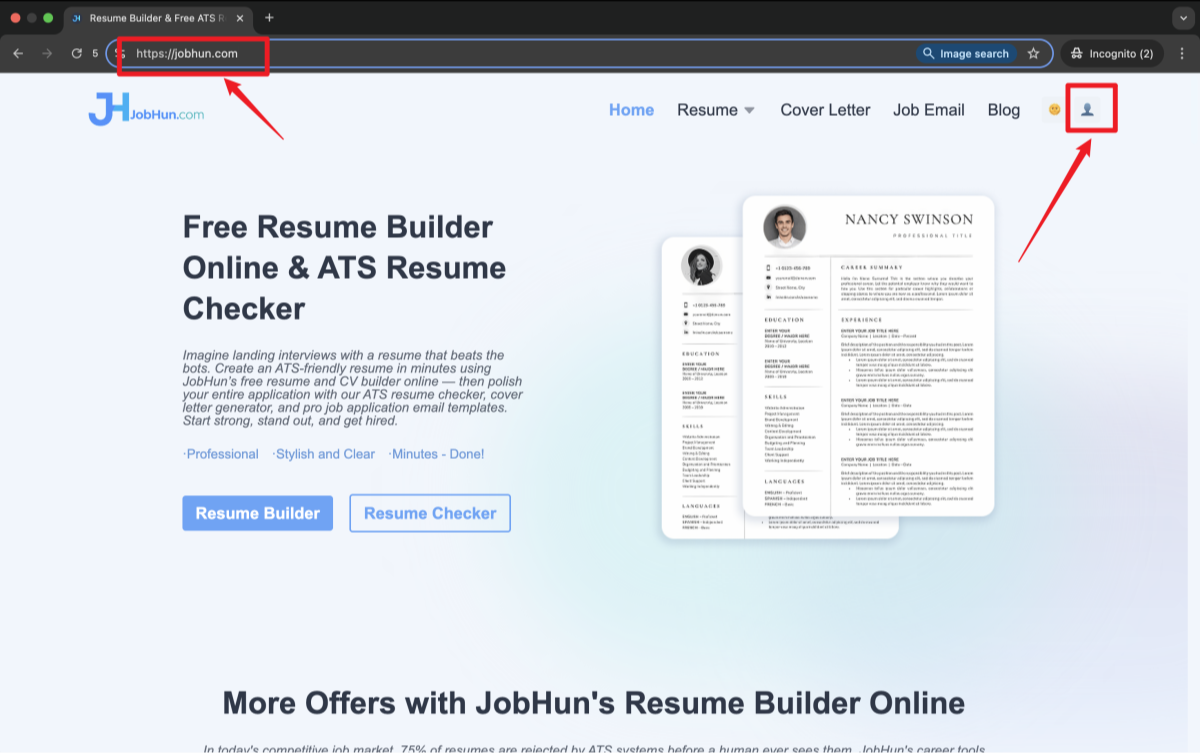
Access the Dashboard
You’ll be directed to the Webapp page.
If you're not signed in yet, the site will show you login or signup options.
Choose one:
- Click “New Resume” to start
- Or hit “Go to Login” in the top right
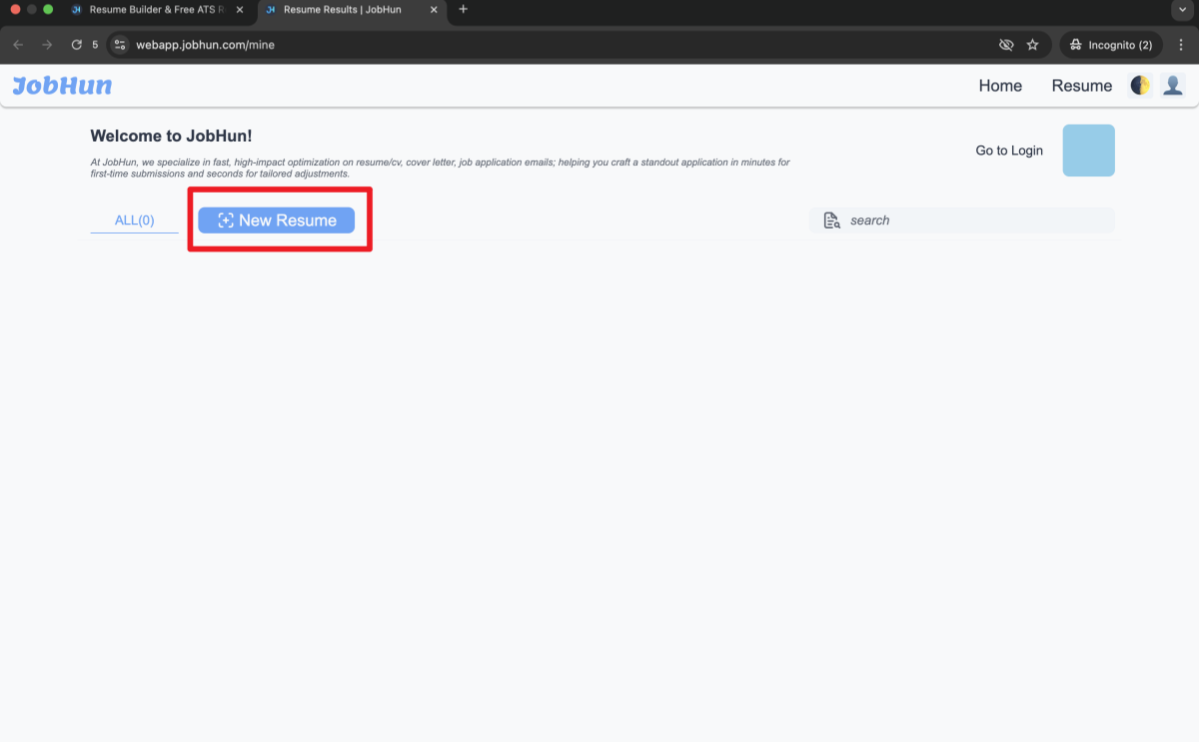
Sign In or Register
Two ways to log in:
- Use your Google account for one-click access
- Or manually enter your name, email, and password, then press “Go”
After logging in, your dashboard will load with your profile info.
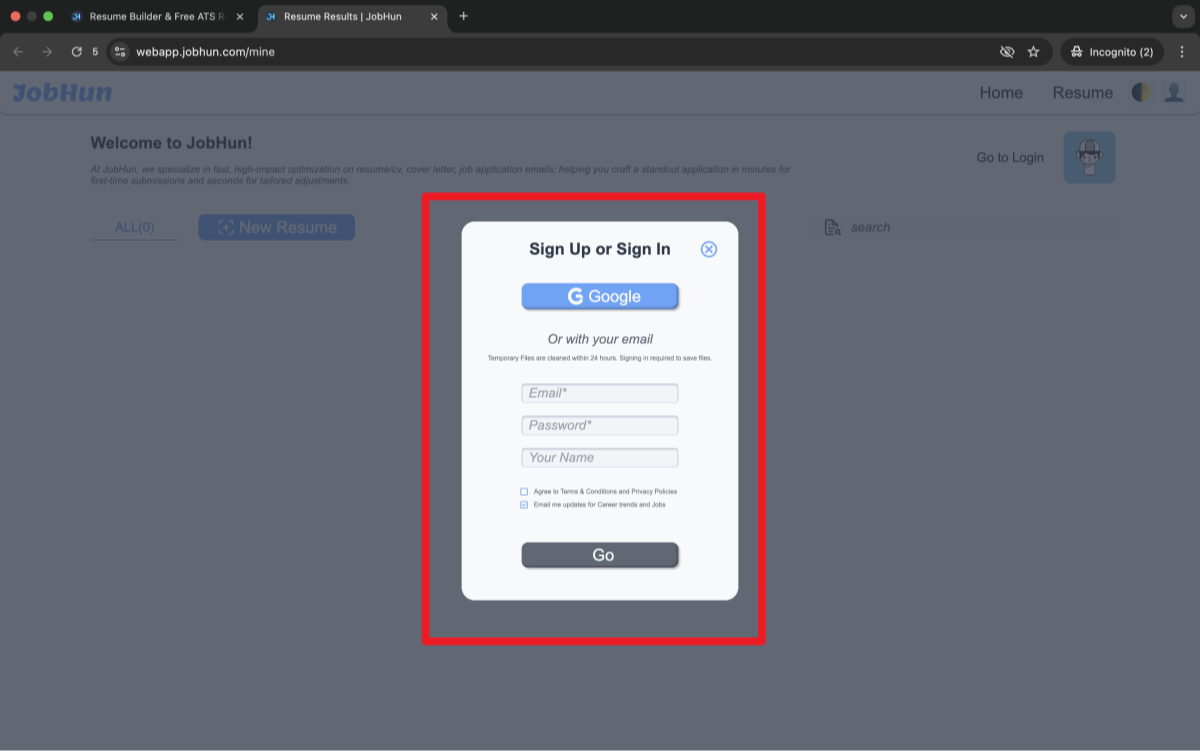
Start Your Resume
Check the top-right corner for your account details to confirm you're signed in.
Click “New Resume” again to launch the builder.
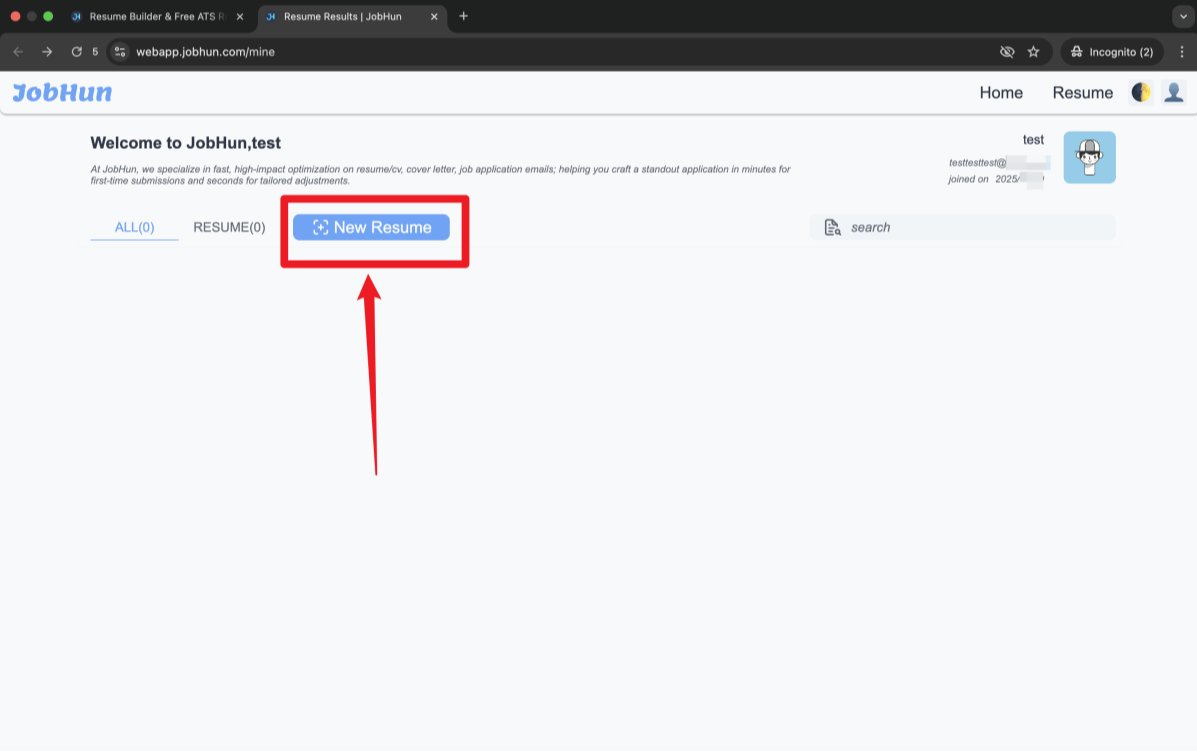
Edit & Finalize
The builder has a two-part layout:
- Left panel: Add and organize sections like Summary, Experience, and Skills
- Right panel: See your changes in real-time
Choose your workflow:
- Let AI generate your resume
- Edit sections manually
- Adjust layout, polish content, and download when ready
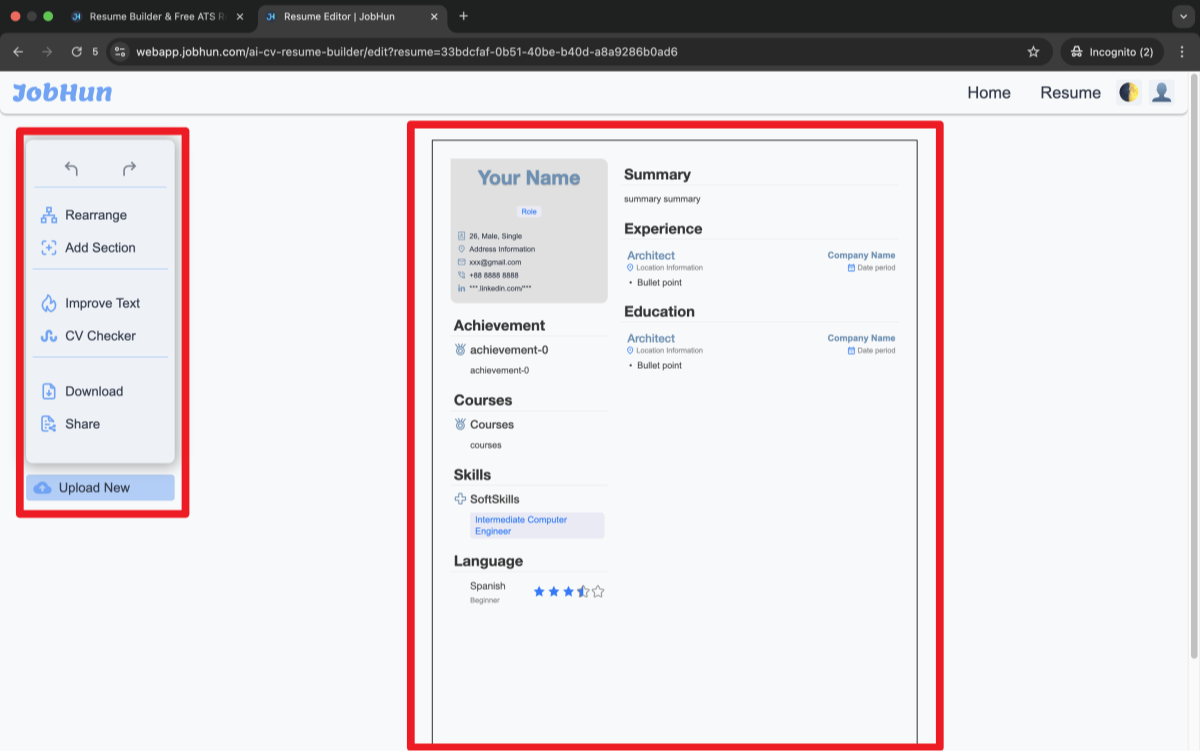
Quick Interview Outfit Checklist
Preparing your outfit carefully is a vital part of job interview dressing and making a strong, professional impression. Use this quick checklist to ensure your interview attire is polished, comfortable, and appropriate for the role:
- Clothes ironed and spotless
- Shoes clean and job-appropriate
- Hair tidy, accessories light
- Everything fits and feels good
- Backup plan for rain or spills
Following this checklist not only helps you dress the part but also supports a positive mindset, which is just as important for interview success. Planning your interview outfit ahead of time lets you focus on your answers and leave a lasting positive impression.
Final Thoughts: Dress for the Role You Want
Knowing what to wear for a job interview goes beyond just picking clothes—it’s about presenting yourself as confident, professional, and ready to take on the role. The right outfit can set the tone for a positive first impression, show respect for the company culture, and boost your own confidence throughout the process.
By researching the company dress code, tailoring your outfit to the industry, and paying attention to the details, you put yourself in the best position to succeed. Remember, your appearance is just one part of your preparation, but it’s an important one that often opens the door to showcasing your skills and personality.
Take the time to plan your interview attire thoughtfully—it could make all the difference between getting the job and missing out. Dress smart, feel confident, and walk into your interview ready to impress.
FAQ
What’s the best color to wear to an interview?
Neutral tones like navy, gray, or black are safe bets. These colors look professional and help keep the focus on your skills and personality rather than your outfit.
Can I wear jeans to a job interview?
Jeans are usually too casual unless you’re interviewing at a company known for a relaxed dress code. When in doubt, it’s better to avoid them and opt for more traditional interview attire.
What should I wear for an interview at a startup or creative company?
A business casual look with a personal touch works well—think a colorful blouse or an interesting accessory. Just be sure to keep your overall appearance neat and polished.
What shoes are most appropriate?
Closed-toe dress shoes, flats, or modest heels are ideal choices. Make sure your shoes are clean and comfortable, as they contribute to a professional and confident appearance.
How do I ask about the dress code in advance?
Simply ask your recruiter or contact person politely, “Could you please share what the dress code is for the interview?” This shows you’re thoughtful and eager to align with the company culture.





